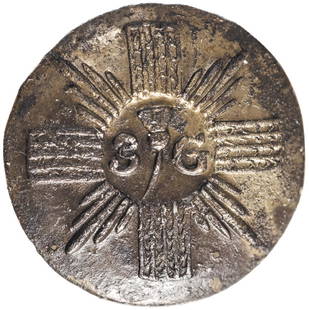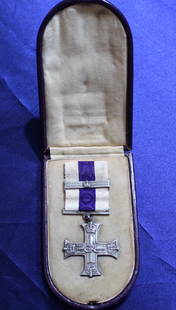
British 66th Regt Pewter Soldier Cuff Button Shank
Similar Sale History
View More Items in Militaria & War MemorabiliaRelated Militaria & War Memorabilia
More Items in Militaria & War Memorabilia
View MoreRecommended Collectibles
View More



Item Details
Description
American Revolution
66th (Berkshire) British Regiment of Foot Cuff Button
66th (Berkshire) Regiment of Foot Soldier's Pewter Cuff Button, .5" diameter, Original Shank, British, Choice Very Fine.
An original Revolutionary War era British Military Soldier's Button of The 66th (Berkshire) Regiment of Foot was an infantry regiment of the British Army, raised in 1756. The formation of the regiment was prompted by the expansion of the army as a result of the commencement of the French and Indian / Seven Years' War. On 25 August 1756 it was ordered that a number of existing regiments should raise a second battalion; among those chosen was the 19th Regiment of Foot. The 2nd Battalion of the 19th Regiment of Foot was formed on 10 December 1756 and renumbered as the 66th Regiment of Foot on 21 April 1758. The regiment was posted to Jamaica in 1764 and then returned home in 1773. The regiment was given a county designation as the 66th (Berkshire) Regiment of Foot in 1782.
French and Indian War: (1754 to 1763)
What came to be known as the Seven Years' War (1756"1763) began as a conflict between Great Britain and France in 1754, when the British sought to expand into territory claimed by the French in North America. The war came to be known as the French and Indian War, with both the British and the French and their respective Native American allies fighting for control of territory. Hostilities were heightened when a joint British and native Mingo force (led by a 22-year-old Lt. Colonel George Washington and Chief Tanacharison) ambushed a small French force at the Battle of Jumonville Glen on 28 May 1754. The conflict exploded across the colonial boundaries and extended to Britain's seizure of hundreds of French merchant ships at sea.
The British settlers along the coast were upset that French troops would now be close to the western borders of their colonies. They felt the French would encourage their tribal allies among the North American natives to attack them. Also, the British settlers wanted access to the fertile land of the Ohio River Valley for the new settlers that were flooding into the British colonies seeking farm land.
The most important French fort planned was intended to occupy a position at "the Forks" where the Allegheny and Monongahela Rivers meet to form the Ohio River (present-day Pittsburgh, Pennsylvania). Peaceful British attempts to halt this fort construction were unsuccessful, and the French proceeded to build the fort they named Fort Duquesne. British colonial militia from Virginia accompanied by Chief Tanacharison and small number of Mingo warriors were then sent to drive them out. Led by George Washington, they ambushed a small French force at Jumonville Glen on 28 May 1754 killing ten, including commander Jumonville.
The French retaliated by attacking Col. George Washington's army at Fort Necessity on 3 July 1754 and forced Washington to surrender. These were the first engagements of what would become the worldwide Seven Years' War.
KEYWORDS:
Button Collecting, American Revolutionary War Military Button, Historic British Army Buttons, Rare Buttons
66th (Berkshire) British Regiment of Foot Cuff Button
66th (Berkshire) Regiment of Foot Soldier's Pewter Cuff Button, .5" diameter, Original Shank, British, Choice Very Fine.
An original Revolutionary War era British Military Soldier's Button of The 66th (Berkshire) Regiment of Foot was an infantry regiment of the British Army, raised in 1756. The formation of the regiment was prompted by the expansion of the army as a result of the commencement of the French and Indian / Seven Years' War. On 25 August 1756 it was ordered that a number of existing regiments should raise a second battalion; among those chosen was the 19th Regiment of Foot. The 2nd Battalion of the 19th Regiment of Foot was formed on 10 December 1756 and renumbered as the 66th Regiment of Foot on 21 April 1758. The regiment was posted to Jamaica in 1764 and then returned home in 1773. The regiment was given a county designation as the 66th (Berkshire) Regiment of Foot in 1782.
French and Indian War: (1754 to 1763)
What came to be known as the Seven Years' War (1756"1763) began as a conflict between Great Britain and France in 1754, when the British sought to expand into territory claimed by the French in North America. The war came to be known as the French and Indian War, with both the British and the French and their respective Native American allies fighting for control of territory. Hostilities were heightened when a joint British and native Mingo force (led by a 22-year-old Lt. Colonel George Washington and Chief Tanacharison) ambushed a small French force at the Battle of Jumonville Glen on 28 May 1754. The conflict exploded across the colonial boundaries and extended to Britain's seizure of hundreds of French merchant ships at sea.
The British settlers along the coast were upset that French troops would now be close to the western borders of their colonies. They felt the French would encourage their tribal allies among the North American natives to attack them. Also, the British settlers wanted access to the fertile land of the Ohio River Valley for the new settlers that were flooding into the British colonies seeking farm land.
The most important French fort planned was intended to occupy a position at "the Forks" where the Allegheny and Monongahela Rivers meet to form the Ohio River (present-day Pittsburgh, Pennsylvania). Peaceful British attempts to halt this fort construction were unsuccessful, and the French proceeded to build the fort they named Fort Duquesne. British colonial militia from Virginia accompanied by Chief Tanacharison and small number of Mingo warriors were then sent to drive them out. Led by George Washington, they ambushed a small French force at Jumonville Glen on 28 May 1754 killing ten, including commander Jumonville.
The French retaliated by attacking Col. George Washington's army at Fort Necessity on 3 July 1754 and forced Washington to surrender. These were the first engagements of what would become the worldwide Seven Years' War.
KEYWORDS:
Button Collecting, American Revolutionary War Military Button, Historic British Army Buttons, Rare Buttons
Buyer's Premium
- 30%
British 66th Regt Pewter Soldier Cuff Button Shank
Estimate $240 - $320
2 bidders are watching this item.
Shipping & Pickup Options
Item located in Rancho Santa Fe, CA, usOffers In-House Shipping
Payment

TOP

































![[CIVIL WAR]. Sixth plate ambrotype of Frank M. Chamberlin, Co. I, 79th New York Volunteers. N.p., ca: [CIVIL WAR]. Sixth plate ambrotype of Frank M. Chamberlin, Co. I, 79th New York Volunteers. N.p., ca 1862. Seated portrait of a youthful soldier wearing a regulation 4-button sack coat and having a be](https://p1.liveauctioneers.com/197/309287/165438737_1_x.jpg?height=310&quality=70&version=1699649440)




![[CIVIL WAR] 6 General Staff Officer Buttons: A group of six (6) "General Staff" small cuff or vest buttons. Four are marked "Waterbury Button Co. / Extra" to reverse. One is marked "W.B. Smith & Co. / New York". One is marked "Horstmann Bro. & A](https://p1.liveauctioneers.com/7226/325455/175169019_1_x.jpg?height=310&quality=70&version=1712370394)
![[CIVIL WAR] Irish Soldier’s Antietam ID Disc: McClellan & Antietam soldier's pewter ID badge. Obverse features profile bust portrait of General George B. McClellan with the legend, "Antietam / Sept 17th 1862". Reverse is stamped: "Co. C. / 51. N.](https://p1.liveauctioneers.com/7226/325455/175169060_1_x.jpg?height=310&quality=70&version=1712370394)




![[Civil War] Bullet Which Nearly Killed Soldier: Lead bullet encased in gold acorn fob with chain. Finely engraved: "W.D. Fiske / 14th Regt. C V / Fredericksburg / Dec 17, 1863." Acorn approx. 1 1/2 x 1 in. Overall length 6 1/2 in. Published in "Her](https://p1.liveauctioneers.com/7226/325455/175169103_1_x.jpg?height=310&quality=70&version=1712370394)





![[Civil War Gettysburg] 107th PA ID Disc: Gilt brass "Against Rebellion" soldier's ID tag. Obverse features a patriotic shield reading "Union" with the legend "Against Rebellion / 1861." Reverse stamped "John Orth . / Co. E / 107th / Regt. /](https://p1.liveauctioneers.com/7226/325455/175169068_1_x.jpg?height=310&quality=70&version=1712370394)


![[CIVIL WAR] Black Soldier & Wife: CDV-sized tintype photograph WITH gem-sized tintype. Full thermoplastic case. Portrait of an unknown African American Civil War soldier who holds the rank of sergeant. He looks directly at the camera](https://p1.liveauctioneers.com/7226/322253/173251671_1_x.jpg?height=310&quality=70&version=1710004847)





![George Washington Signed Discharge: Partly printed discharge document signed by George Washington, as Commander in Chief of the Armies of the United States. Newburgh, [New York], 4 January 1783. 1 page, ## x ## in. Undersigned by Washin](https://p1.liveauctioneers.com/7226/322253/173251475_1_x.jpg?height=310&quality=70&version=1710004847)
![[Ambrotype] Texas Confederate Soldier: Sixth plate ambrotype. Full leatherette case. Portrait of a possible Texas Confederate soldier. A silver star device was used to pin up the brim of his light-toned headgear, a look often seen in image](https://p1.liveauctioneers.com/7226/322253/173251509_1_x.jpg?height=310&quality=70&version=1710004847)

![Captured Bowie Knife w/ Period Note of Provenance: Captured Confederate D-hilt Bowie knife. [Kenansville, North Carolina]: [Louis Froelich factory]. With original metal and leather sheath with affixed period notes. First note with only remnants. Secon](https://p1.liveauctioneers.com/7226/325455/175169154_1_x.jpg?height=310&quality=70&version=1712370394)
![[CIVIL WAR] 1st Texas Infantry in Camp: Outdoor half plate ambrotype of the 1st Texas Infantry. Full leatherette case. Significant, large half plate ambrotype of members of the 1st Texas Infantry at ‘Splinterville,’ the regiment’s win](https://p1.liveauctioneers.com/7226/322253/173251512_1_x.jpg?height=310&quality=70&version=1710004847)
![[HANCOCK, John] Washington’s Spy, Officer’s Commission: Partly printed document signed by John Hancock as President of the Continental Congress, for Epaphras Bull (1748-1781). [Philadelphia, Pennsylvania], 10 January 1777. 1 page, ## x ## in. Completed in](https://p1.liveauctioneers.com/7226/322253/173251471_1_x.jpg?height=310&quality=70&version=1710004847)
![Historic Einstein Signed Program from Lincoln University Visit: Conferences on Objectives. Lincoln University, [Oxford], Pennsylvania, 3 May 1946. SIGNED BY ALBERT EINSTEIN. Tipped into Horace Mann Bond (1904-1972). The Education of the Negro in the American Socia](https://p1.liveauctioneers.com/7226/322253/173251693_1_x.jpg?height=310&quality=70&version=1710004847)

![[CIVIL WAR] Captured Confederate Canteen: Wooden drum canteen with iron hardware. "C.S.A." painted in white ink/paint to side. Period ink inscribed label affixed to side reading in full: "Confederate Canteen Captured from a Confederate soldie](https://p1.liveauctioneers.com/7226/325455/175169142_1_x.jpg?height=310&quality=70&version=1712370394)









